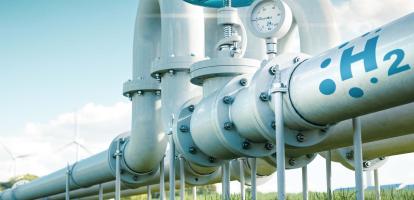Study In Brief
- Canadian homes emit about six percent of Canada’s total greenhouse gas (GHG) emissions. The Federal government aims to bring down 2030 building emissions by 42 percent compared to 2019, with the entire economy producing net zero emissions by 2050.
- This report examines current sources of emissions from Canadian homes and presents a scenario in which air and water heated by fossil fuels are retrofitted with electrical heat pumps.
- Our modeling finds that Canada would need to retrofit over 400,000 dwellings per year to fully electrify all dwellings by 2050 and meeting 2030 targets requires even more aggressive action: over half a million retrofits would be required per year.
- Even in an extreme scenario where no new emitting buildings came on the market after 2022, emissions only fall by about 26 percent to 2030, still not enough to meet government targets.
- Retrofits aren’t cheap. Meeting the 2050 target could cost between $4.5 billion to $6.3 billion per year. This is roughly equal to two or three modern hospitals per year.
- Numbers like these show that other emissions-reducing measures will have to bear more of the burden. These include energy efficiency improvements to homes, building code revisions, and combining heat pumps with traditional natural gas furnaces.
Introduction
Heating, cooling and lighting Canadian buildings takes a lot of energy. In 2019, commercial and residential buildings together were responsible for 25 percent of the country’s total energy consumption, more than the entire transportation sector.
Canada’s federal government has committed itself to the achievement of a net-zero economy by 2050 and a 40-45 percent reduction in 2005-level emissions by 2030. In 2020, Canadian greenhouse emissions totaled 672 million tonnes of carbon dioxide equivalent (MTCO2eq) across seven different economic sectors, compared to 739 MT in 2005. In order to meet these targets, each of the economic sectors will have to be addressed accordingly. The buildings sector, which is this report’s interest, was responsible for over 13 percent of Canada’s emissions in 2020 (Figure 1) – the third largest emitting sector after oil and gas and transportation. In contrast to most other sectors, building emissions have risen since 2005 (Figure 1). The federal government’s 2030 Emissions Reduction Plan (ERP), published in March 2022, aims for a reduction in building sector emissions of 42 percent from 2019 levels by 2030.
Until recently, analysts have paid less attention to the buildings sector than to higher-emitting sectors like transportation or oil and gas. That is changing. In the summer of 2022, Natural Resources Canada published a discussion paper and launched an engagement process to inform its Canada Green Buildings Strategy.
This E-Brief examines the practical implications of decarbonizing residential buildings using a simple scenario in which electricity powers all space (air) and water heating. While the buildings sector comprises all types of buildings, this paper centers on residential buildings, responsible for about half of the building sector’s total emissions (commercial buildings emit roughly the same amount yet from far fewer buildings). Proportionally, the Emission Reduction Plan’s sectoral goal implies residential emissions should fall from about 44 MT in 2019 to 25 MT in 2030.
This paper develops a scenario for reducing or eliminating GHGs from residential buildings with the technologies available today, and estimates the costs and needed pace in such a scenario.
Our analysis focuses on direct emissions reductions through the possible electrification of space and water heating (“decarbonizing”): the vast majority (99 percent) of Canada’s residential emissions are produced by those two heating categories. Along with efficiency measures (using less energy of all kinds), electrifying fossil-fuel powered heating systems is widely considered to be the most feasible pathway for the sector and is possible with technologies that are on the market today. This paper considers a fully electrified residence “emissions-free,” although it’s possible a small amount could arise in the form of leaking gas from a refrigerator, for example (refrigerant gases are GHGs).
Greater demand for electricity could generate more emissions should the needed electricity be powered by emitting sources, such as by fossil fuels without any mitigating actions like carbon capture. Electricity-generated emissions data are included in the electricity sector, in accordance with Canada’s national inventory report accounting framework, and are outside the formal scope of this paper. Reducing economy-wide emissions depends critically on electrification though and we briefly address it in a text box below. The federal government is targeting a net-zero electricity sector by 2035, so, theoretically at least, emissions past that point won’t rise with demand.
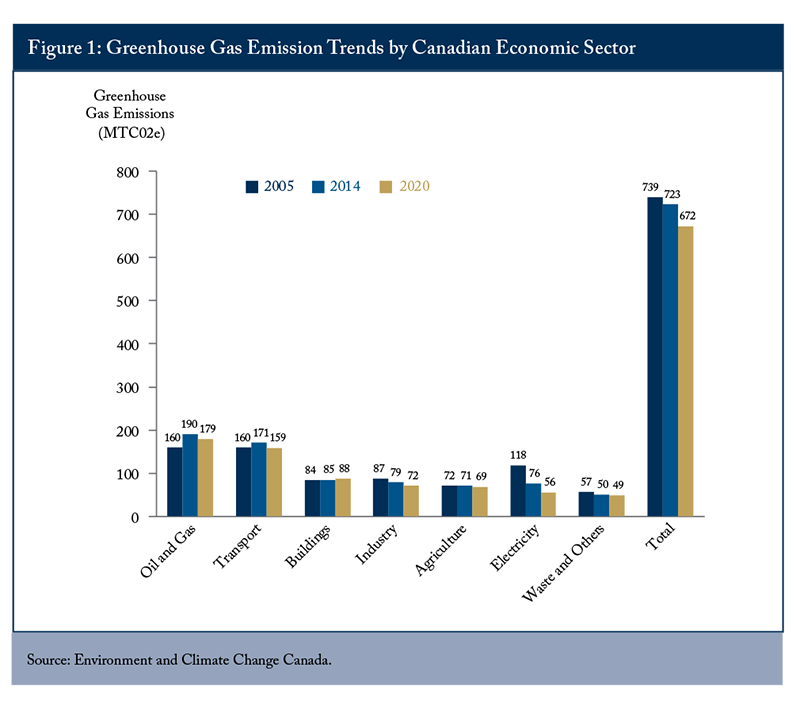
Space heating (making sure our living spaces are warm enough) generates over three-fourths of residential emissions, with water heating responsible for most of the remaining portion (Figure 2). Non-heating processes from things like lighting, refrigeration and gas stoves emit only about 1 percent of direct residential emissions (not including the emissions created in generating electricity for appliances).
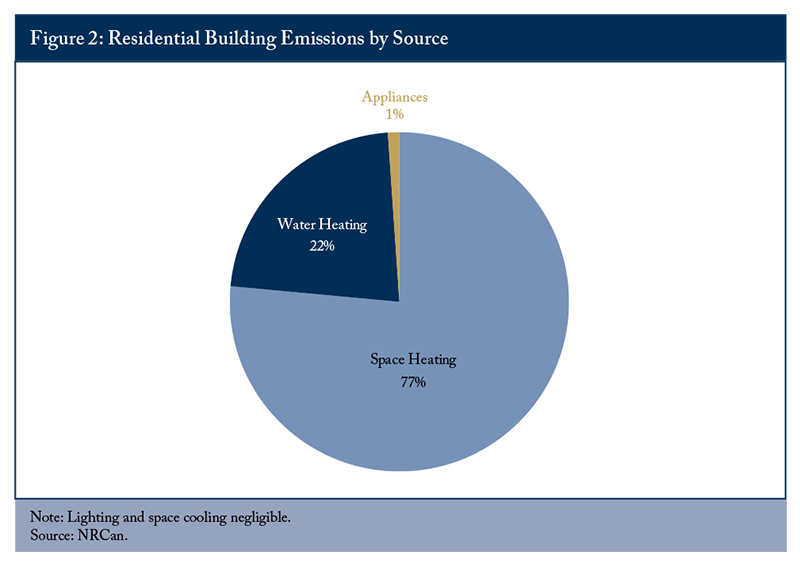
While switching from fossil fuels to electricity is the primary mechanism to reduce residential emissions in the medium term, and is thus our focus, electrification is not the only way to reduce emissions. Energy efficiency measures to reduce total energy demand can be foundational. Steps like properly sealing windows and doors, adding attic insulation or replacing inefficient appliances with efficient ones can be done relatively inexpensively, while steps like building-envelope sealing, replacing windows or doors, or undertaking deep retrofits to reach “net zero” or “passive house” standards are much more expensive.
We do not formally incorporate emissions “embedded” in the products used to build, dismantle, or retrofit homes; their direct emissions fall outside the residential sector. (Trucking lumber to a building site creates emissions in the transportation sector, for example.) In practice, these analyses are often complementary to other electrification activities: for example, it’s cheaper to buy and operate a smaller heat pump (with lower embedded emissions) if you can reduce the heating load in the first place.
Using fuels with lower life-cycle emissions in existing natural gas applications also holds significant potential. These fuels include renewable natural gas (or RNG, normally captured methane from biologic processes) or hydrogen created through low-emitting processes.
Economy-wide or systemic “optimal” emissions reductions is beyond this paper’s scope. For example, adding electrified heating increases electricity demand, all else equal, thereby increasing emissions caused to generate it. While electrification alone will undoubtedly increase demand, it is certainly possible that countervailing efficiency measures, often undertaken at the same time as heat pump installation for example, may reduce demand for electricity. These topics will surely be part of reducing sector emissions, but they are not formally considered in our scenario-based analysis.
Our analysis focuses exclusively on determining what it would cost to electrify Canada’s entire space and water heating stock as a means of decarbonizing the residential sector. The analysis does not comment on the likelihood of achieving the emissions reductions outlined by the Canadian government, nor take a position as to the degree of ambition.
The paper concludes that our simplified “what if” scenario of replacing new and existing space and water heating with electric heat pumps will be expensive and require a pace of retrofits several times than it is today. This implies such a scenario is unlikely to be the fastest and most-cost effective path.
We find that
- About ten million Canadian homes emit GHGs. Ontario is home to just under five million of them.
- Despite its large population, Quebec faces a relatively smaller challenge since about two-thirds of homes there already rely on electricity.
- Cost-effective emissions-reduction varies widely by building type, building size, building age, region, climate, as well as differences in access to and cost of electricity compared to other fuels.
- Canada would need to retrofit about 423,000 dwellings per year (assuming no new GHG emitting builds past 2030) to fully electrify all dwellings by 2050.
- Meeting 2030 targets requires even more aggressive action: over half a million retrofits would be required per year, and no emitting homes could be built past 2022. For comparison purposes, that number of retrofits is more than the entire housing stock of Saskatchewan (approximately 485,000 units).
- Early action, particularly on newly constructed homes, reduces the need for, and cost of, future interventions. Given buildings’ long lives, it makes little sense to install high-emitting systems now if there is a looming potential to face future high fuel prices or undertake unanticipated retrofits. Retrofit needs drop by almost 2.2 million units, and the annual retrofit rate required to meet 2050 targets would drop to about 355,000 per year if no new emitting buildings came on the market after 2022 (admittedly unrealistic). Even with such an aggressive assumption, emissions only fall by about 26 percent to 2030, still not enough to meet government targets.
- Whether paid by the consumer or taxpayer, retrofits aren’t cheap. On a Canada-wide basis, meeting the 2050 target will cost between $4.5 billion to $6.3 billion per year. This is roughly equal to two or three modern hospitals per year.
- Consumers need to know that future electricity use will be affordable. Electricity underpins progress on decarbonization and consumers will be more willing to undertake electrification investments if they know they won’t face nasty future price hikes, especially compared to other energy sources like natural gas.
- Dual-fuel solutions can reduce emissions with existing infrastructure. Though technically an emitting option, combining heat pumps with natural gas furnaces and smart controls can be done at relatively low incremental cost and can reduce emissions by over half.
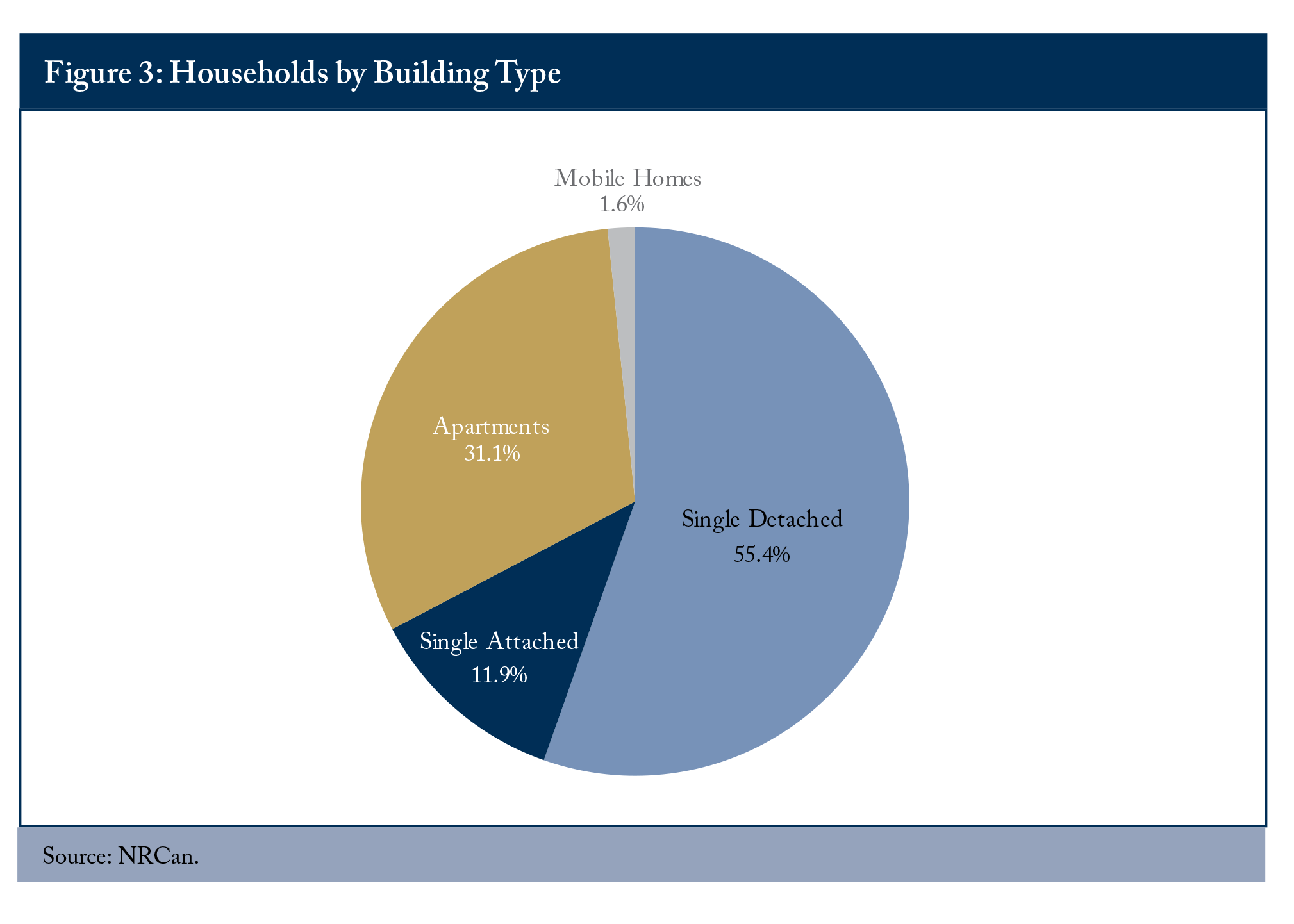
Canada’s Residential Buildings
Before looking at what electrification might cost, we need a fuller picture of Canadians’ existing homes and those they might build. Understanding the different ways Canadians have built and warm their homes across the country underpins the analysis.
Existing Homes and Heating Systems
Reliable estimates indicate there are about nine million residential buildings representing over 15 million dwellings (Haley and Torrie 2021). A dwelling is a distinct living unit; a residential building such as an apartment building contains many dwellings. The residential sector includes everything from personal residences such as attached or detached homes, to apartments and condominiums, to mobile homes and farm houses. As Figure 3 shows, just over half of Canadians live in single detached homes, and about a third live in apartments. A smaller share live in single attached and mobile homes.
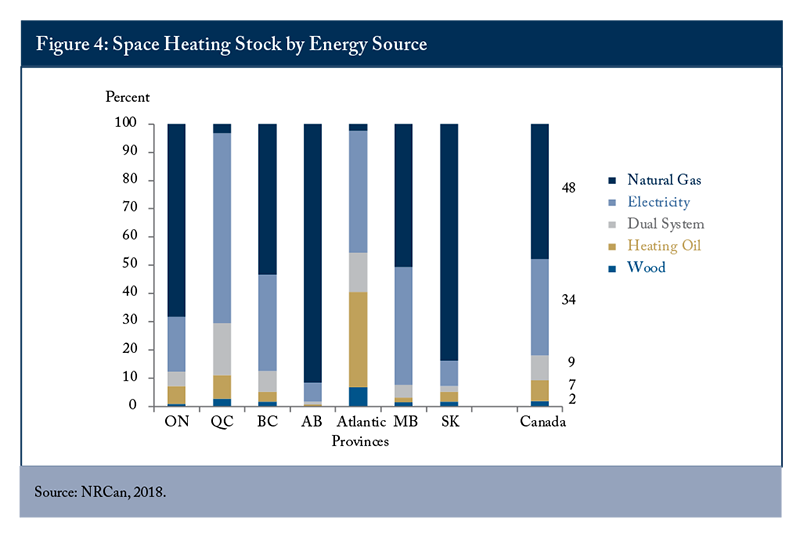
Natural gas fuels just under half of Canadian heating systems (Figure 4). Electric space heating from baseboard heaters and heat pumps represents just over a third of the country’s total, while dual systems, heating oil, and wood occupy the majority of the remaining share. Water heating is less varied, with roughly 52 percent of heaters powered by natural gas and 43 percent from electricity.
The way Canadians heat their homes also varies widely across provinces. Installed home heating systems vary depending on climate, resource availability and cost, dwelling age and type, availability of natural gas connections, and more. As a result, provinces have developed starkly different heating systems.
Almost 70 percent of Quebec homes use electricity as their primary heat source, while 92 percent use natural gas in Alberta. Atlantic Canada depends the most on heating oil, at roughly a third of their total stock, while communities in northern Canada often depend on diesel.
Since this paper examines residential building emissions from the perspective of whether home air and water heating is electrified or not, the next step is determining the share of existing homes requiring a retrofit.
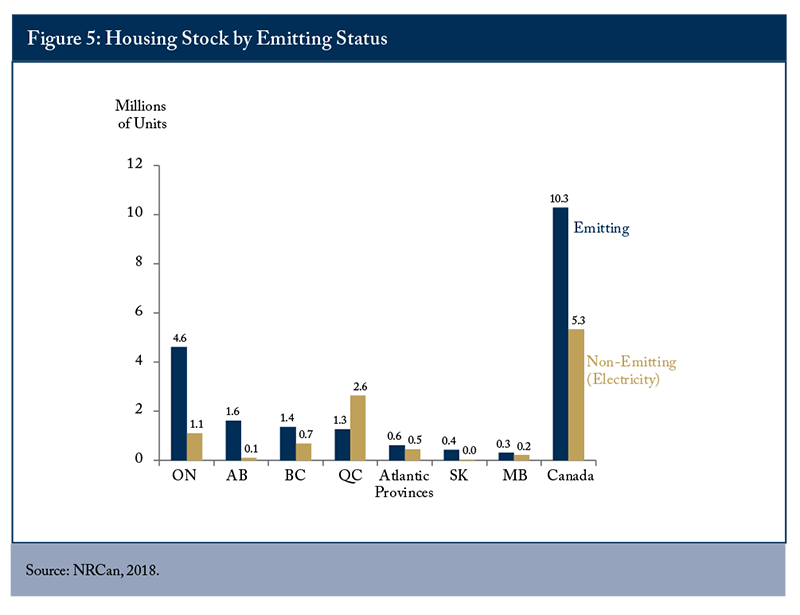
Figure 6 groups emitting dwellings and contrasts them with non-emitting dwellings or those with electric heat.
Clear regional patterns emerge, with dwellings in Quebec, the Atlantic Provinces, Manitoba, and British Columbia more likely than others to be electrified. This is not surprising, given the relative cost advantage and emissions stability conferred on them by large hydroelectric generation. However, electricity-powered heating is by no means universal within any region: even Quebec, which has the greatest share of electrified homes, relies on emitting sources for a third of its dwellings. In total, about 5.3 million Canadian homes are electrified, leaving 10.2 million to be retrofitted.
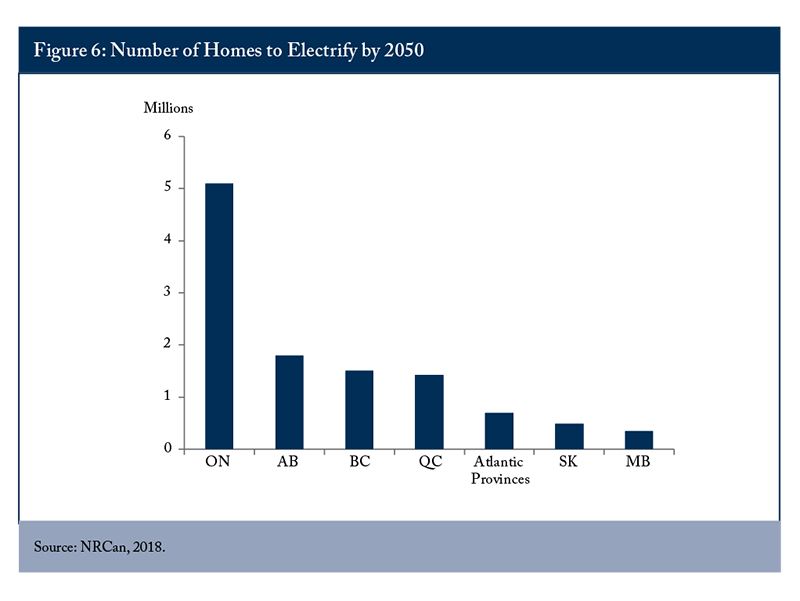
In order to calculate how many homes will need to be electrified by 2050, one must also understand the number of new homes and their emissions characteristics.
We expect average annual additions to the housing stock to grow at roughly the same rate as it has for the past few years. This is driven by long-term demand trends, forecasts of continued population growth, and average household size appearing to stabilize after years of decline.
Over the past five years, Canadian builders completed roughly 200,000 new units (dwellings) per year. Multi-unit buildings
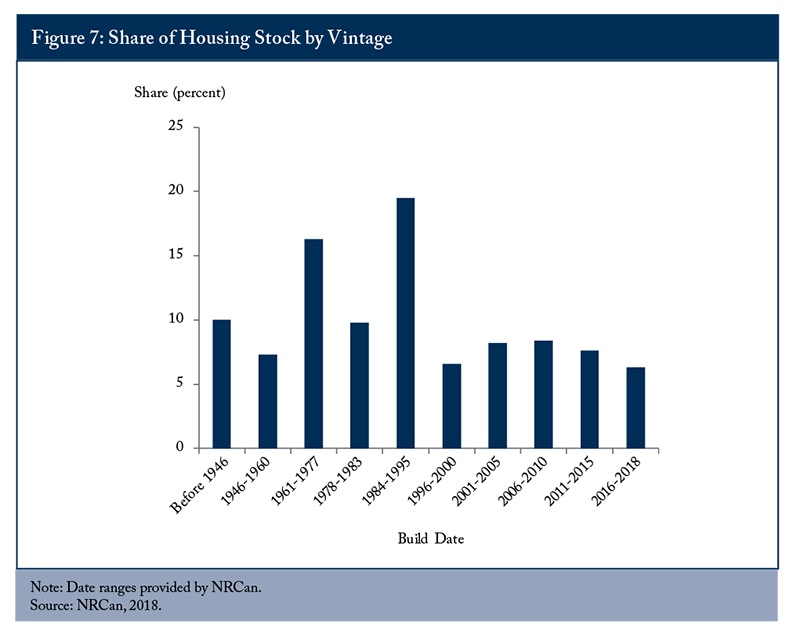
New homes are much more efficient (use less energy) than those built decades ago, with improvements driven by consumer demand, improved construction techniques, better technology, and stricter building codes.
- passive house design strategies like optimized window selection and shading;
- energy modeling in the design phase;
- tightly sealed building envelopes with controlled ventilation;
- optimized insulation in floors, walls, ceilings, and slabs, reducing thermal bridging; and
- efficient lighting and heating appliances.
Within the array of countless options available to new home-buyers, efficiency or carbon emissions are not always the first things they think about. Most new home-buyers choose the default heating systems offered to them, often and understandably, driven by affordability concerns. That means that each day owners of brand-new homes turn on the furnace and cook dinner fueled by natural gas or heating oil having had little option beyond this default level of efficiency. Buyers of pre-owned residences obviously face even less choice.
To model future additions of emitting homes we assume that post-2018 they begin to become electrified on a straight-line basis to 2030, at which point emitting space and water heating is no longer allowed by municipalities or provinces. We further assume that all homes, new additions plus the existing stock, are retrofitted by 2050.
The Size of the Challenge
From the discussion above, adding existing emitting homes to the number of yet-to-be-built emitting homes gives us a sense of the total number of homes to be electrified before 2050. We assume residential emissions must fall proportionately to the buildings sector goals of net zero by 2050.
Canadian housing stock in 2018 numbered about 15.6 million (with about 14.8 million occupied households). Of those, about 5.3 million were heated with electricity, leaving 10.3 million, or about two-thirds, requiring retrofit. Even with greater penetration of electric heating in newly constructed homes between 2018 and 2030, our estimates suggest a further 3.2 million emitting homes will be built. This leaves a total of 13.5 million homes needing to be electrified by 2050. On average almost 422,600 homes will need to be retrofitted each year (1,158 per day). This is roughly equivalent to retrofitting the total number of Saskatchewan households each year for over 30 years.
Regionally, Ontario faces the largest challenge with over 5 million homes to electrify, owing to its large population and relatively low level of electrification. Despite Quebec’s significant population, the number of homes to retrofit compared to total households is relatively small, though still substantial on an absolute basis at 1.7 million.
Almost two-thirds of Canadian homes are over 25 years old (Figure 8). In most cases, the concept of heating air or water with electricity did not fit local conditions and was never contemplated.
Removing existing natural gas or oil-fueled furnaces or heaters, ensuring adequate supporting infrastructure such as venting, wiring, and electrical system capacity, and subsequent equipment and installation costs can be very expensive. Furthermore, the Canadian housing stock is highly heterogeneous. Homes vary greatly by region, fuel source, building type (detached/attached/apartment), size, and age.
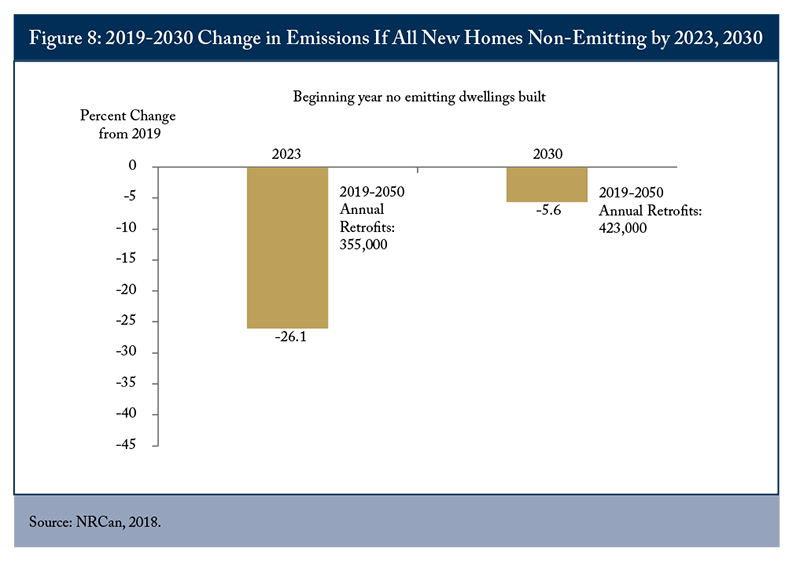
Residences can be electrified in several ways including with resistance heating such as baseboard heating or electric furnaces, ground-source heat pumps, or air-source heat pumps. Heat pumps use electricity to pull heat from one place to another.
Determining the total cost of decarbonizing the residential sector is particularly challenging because the upfront cost of installing these heating technologies ranges dramatically. The unique characteristics of each dwelling, the climate, and the amount the owner is willing to spend will dictate this outcome. For instance, ground-source heat pumps (which are not suitable for all homes) are generally more expensive than air-source heat pumps due to excavation costs, although they yield lower energy bills over time. The decision to elect one over the other will be based upon various factors suited particularly to the homeowner in question.
Nonetheless, air-source heat pumps are becoming increasingly popular due to the fact that they can be installed more easily in older homes, are cheaper than ground source-heat pumps, and more efficient than baseboard heaters. Variation exists within this technology. Air-source heat pumps come in two forms; ducted or ductless, which refers to the method in which air is transported throughout the home. Ductless heat pumps are less intrusive to install but may require multiple units to heat an entire home, while ducted heat pumps can heat an entire home by transporting warm air through a system of vents.
While a central-ducted heat pump could replace a natural gas furnace, it’s not always the best solution to achieve fully electrified heating. For example, it may be more cost-effective to install multiple “mini-split” heat pumps (mini-splits are designed for single spaces) when replacing a boiler and radiator system than installing ductwork to accommodate a central heat pump with forced air.
“Cold climate” air-source heat pumps are more expensive than those designed for warmer climates, and are continually improving the minimum temperatures at which they are effective. Despite improvement, very cold regions will require backup resistance electric heat (or a backup fossil fuel option if not fully electrified) as a backstop for certain times of the year, primarily because even cold-climate heat pumps become less effective as temperatures drop. In addition, heat pumps used year-round don’t tend to last as long as furnaces.
Additionally, heat pumps may require upgrades to the electricity panel or wiring. In many homes heated by natural gas or oil, electric service is limited to 100 amperes (amps).
Hot water, a household necessity, can be heated many ways: by combusting natural gas or oil, via solar array, or through electrical means.
There cannot exist a single “ideal” emissions-reducing intervention for any particular home. Solutions differ for air source heat pumps for space and water heating, with no single “average” size, equipment cost, and installation cost and no “average” climate, region, dwelling type, existing heating system, dwelling size, and age. Despite that, to say anything useful on an aggregate basis we must make simplifying assumptions. We assume an average retrofit package of a cold-climate air-source heat pump, a heat pump water heater, and installation. Given heat pumps’ technical limitations in very cold climates like Canada’s, this is likely an optimistic, or low cost, assumption. Admittedly, it’s also a coarse assumption which sacrifices granularity but is unavoidable in the analysis.
After surveying a range of literature (for example, the Canada Energy Regulator (2019), Haley and Torrie (2021), Kennedy and Frappé (2021)), we assume a “typical” detached home retrofit costs $18,000 (both space and water heating).
We assume new-build incremental electrification costs are half of any existing home retrofit to account for efficiencies in supplying, installing, and sizing equipment (for example, by minimizing energy requirements by prioritizing efficiency up front). Spreading the cost across attached homes and apartments, which are generally smaller and can introduce economies of scale, reduces the average cost by 20 percent. Across all building types (except for mobile homes at less than two percent of the total), we estimate a cost of $14,500, with a range of uncertainty of, say, $12,000 to $17,000.
Our cost estimates do not include the transaction costs or “hassle factor” to a homeowner or renter going through the process. Time and energy spent gathering information, communicating with city officials or contractors, co-owners, or others may be significant. The value of this time, or the opportunity cost, is not explicitly recognized in this analysis. The owner or occupant is not the only entity affected: municipalities and other regulators must be made aware of retrofits, provide guidance, and issue permits. These actions are not costless. Additionally, this estimate excludes any potential increase in operating cost (electricity rate increases essentially) that could arise should the cost be higher than that of the replaced fuel.
Averaging the needed retrofits implies that about 423,000 dwellings need to be decarbonized annually (assuming no new emitting builds past 2030).
2030 Emission Reduction Plan (ERP) Targets
Translating retrofits needed into corresponding emission reductions with a straight-line decline to zero at 2050, implies that the number of emitting units, and thus emissions, doesn’t fall much (about six percent) to 2030 (Figure 9). The reason? Continually adding new emitting dwellings until 2030 counteracts retrofits of existing buildings. The 6 percent reduction is far below the Emissions Reduction Plan (ECCC 2022) emission reduction target for the sector of 42 percent.
Moving the assumed year after which no emitting dwellings are built (say, by regulation) from 2030 to the earliest possible (2023) helps. Doing so yields a reduction in the total dwellings to be retrofitted by almost 2.2 million units in total and improves the 2030 reduction. Even with such an aggressive assumption, emissions only fall by about 26 percent to 2030, still not enough to meet the target.
To meet the 2030 42 percent reduction target with this model, not only would no zero new emitting homes be built after 2022, but the annual rate of retrofits would need to rise to 516,000 per year.
Discussion and Policy Implications
The analysis reveals that reducing residential emissions by electrifying space and water heating won’t be cheap or simple. Without any other changes, achieving the 2030 ERP targets would require immediately putting an end to emitting new builds, and retrofitting over half a million dwellings per year.
Practical Solutions Require Flexibility
This research presents a deliberately simplified “what if” scenario involving electrification. It cannot address the best or cheapest ways to reduce emissions for individual dwellings. Individual assessment of each home is needed to do that. To start, consumers need data. Cheap and simple estimates of the emissions levels and costs and benefits of making various interventions is needed. This is different from a simple overall energy efficiency measure (though that is useful too) in that it outlines presumed sources and levels of emissions. By doing so, consumers can begin to have a better sense of where emissions come from, how big they are, how much it’s costing them, and what benefit they would get for making a change. They could then make the decision best for them.
Physically retrofitting 100 percent of all Canadian residences with electrified space and water heating is almost certainly not the most efficient way to achieve net-zero in the sector or more widely when electricity demand is considered. Certain types of housing may be particularly difficult and expensive to fit with electrified space and water heating. This could be because of their location, condition and age, or heritage status for example. While less effective than building-envelope sealing or insulation upgrades, non-intrusive efficiency measures such as sealing windows and doors can reduce emissions inexpensively.
Relaxing our assumption of mandating zero-emitting residences likely leads to cheaper ways to lower emissions. A solution pairing heat pumps with natural gas furnaces holds great promise in Canada. These “dual-fuel” systems can reduce emissions substantially by using information technology to optimize the heat source depending on weather conditions.
Dual-fuel systems use the heat pump with the furnace blower for most heating, and will only use gas when it is very cold out, which is when heat pumps struggle to perform (even cold climate versions). These are installed with existing electrical and gas infrastructure, and installation technicians require with little additional training.
Dual-fuel systems can optimize costs if they can incorporate actual fuel prices. By using gas during periods of high electricity demand and assumed high price, it allows the homeowner to avoid high-price periods. If widely used, demand side management can help keep electricity costs down for all by reducing peak demand and avoiding unnecessary infrastructure. Case studies show that emission reductions can be reduced by at least one-third and as much as two-thirds, depending on the size of heat pump chosen.
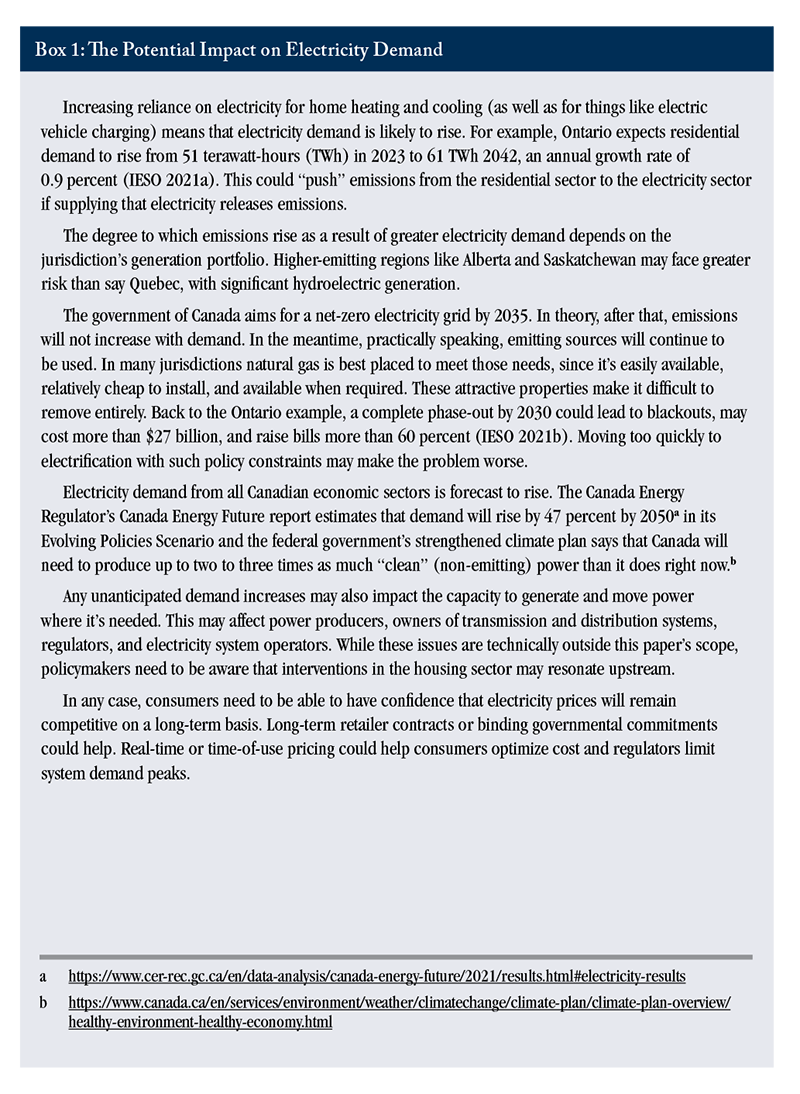
Using lower-emitting fuels like renewable natural gas or hydrogen in dual-fuel systems could further reduce system-wide emissions.
Regions won’t be affected in the same way as homes are decarbonized. Quebec, with a built-in advantage in electric heating, has a far smaller challenge than does Ontario, relative to its population (though still not small in an absolute sense). Provinces like Alberta or Saskatchewan, or parts of British Columbia, reliant on natural gas yet with cold climates, will likely face a relatively larger bill too. Though a full analysis is outside the scope of this E-Brief, they are more likely to require backup resistance heating, adding to the cost of a heat pump. Again, dual-fuel systems can make sense in the medium term.
Regional differences mean that costs disproportionately fall on some regions, and that policies should be designed in a way to address that concern. It also means that more labour needs to be available and the underpinning supply chain needs to be robust in those regions.
Relative Fuel Cost and Expectations
As homes rely more on electricity, they become more exposed to electricity prices as electricity’s share rises as a proportion of total home energy costs. Despite the technical efficiency of electric heat, relative fuel price is critical. The decision to electrify could boost bills if natural gas or heating oil prices remain low compared to electric power. Owners and renters both could be exposed.
The legislated rising price of carbon emissions will no doubt influence relative prices but is not the sole factor. Market risks can be significant. Sudden price increases are very difficult to substitute away from and tend to be regressive, falling disproportionately on low-income Canadians.
While actual relative fuel prices do affect actual cost outcomes, it is the path of expected prices which matter much more to someone contemplating making changes. If a consumer thinks electricity could shoot up for extended periods of time, they are much less willing to make a bet on electricity. Creating and embedding expectations of low future electricity compared to other fuels like natural gas is crucial to investment.
As noted earlier, this analysis does not formally include the cost of time, or “opportunity cost” of interventions. The more time, uncertainty, and paperwork required, the less likely consumers decide to do something. Policymakers need to understand and recognize this, and incorporate this implicit cost in their interventions.
Labour and Supply Availability
Retrofits to electrify space and water heating require skilled labour. Consumers need the ability to hire professionals skilled in assessing, planning and permitting, procurement, and installation. Such skilled labour is relatively fixed in the short term. Unanticipated demand increases may result in higher costs and strained supply chains without much attendant project completion improvements.
Retrofit grants may make the situation even worse: a subsidy in a supply-constrained scenario, could simply result in a price increase equal to the amount of the subsidy, effectively transferring tax dollars to contractors with no policy impact. While it’s conceivable that equipment and labour costs could fall with greater penetration and efficiencies, history suggests that labour and supply cost risk is likely to be higher rather than lower.
Conclusion
Canada’s federal government has proposed to reduce building sector emissions to net zero by 2050. Focusing simply on the residential portion, the task is enormous. In our scenario, this requires retrofitting over 1,100 homes per day with electric space and water heating for over thirty years. Cumulative upfront costs for heat pumps alone would total $140 to $200 billion, excluding other potential retrofits.
The simplified scenario offered here makes clear that reducing residential building emissions is going to take much more than just installing heat pumps.
Electricity cost and reliability will underpin increasing home electrification. Homeowners are much more likely to undertake electrification investments if they think future electricity prices will be low and stable.
Physically replacing 100 percent of emitting residential systems is almost certainly not the most cost-effective way to achieve government aims. For new homes, it’s important to start now, even if solutions are not totally non-emitting. Today, and every day, installers place hundreds of emitting systems; these may need to be removed and replaced before 2050, less than thirty years away. Consideration should be given to encouraging provinces to work thoughtfully with builders to rapidly adopt affordable high-efficiency and low-emissions building codes aligned with that goal.
For both existing and new homes, consumers need to have easily accessible information about their home’s emissions footprint, and the costs and benefits of all emissions-lowering technologies available to them.
Especially for existing homes, emissions reductions are likely easiest if they play to the strengths of their current infrastructure. For example, a great deal of emissions reductions could be made with the use of dual-fuel systems combining heat pumps with natural gas furnaces. Greater availability of high-frequency price data for electricity and natural gas could help improve cost (and emissions) optimization.
Where at all possible, policymakers should look for opportunities to flexibly abate emissions in other parts of the economy at potentially lower cost, including emissions capture.
The goal of a net-zero residential buildings sector is ambitious and won’t be cheap. Federal and provincial governments need to acknowledge and understand the very real costs and trade-offs needed to achieve their ambitions with minimum harm to Canadians.
The authors thank Benjamin Dachis, Chris Benedetti, Colin Guildimann and several anonymous reviewers. The authors retain responsibility for any errors and the views expressed.
References
Balyk, Joel, Brian Livingston, Sara Hastings-Simon, and Grant Bishop. 2021. Driving Ambitions: The Implications of Decarbonizing the Transportation Sector by 2030. Commentary. Toronto: C.D. Howe Institute. Available online at https://www.cdhowe.org/sites/default/files/attachments/research_papers/mixed/Commentary_604.pdf.
Canada Energy Regulator. 2019. “Market Snapshot: Growing heat pump adoption – how does the technology work?” Available online at https://www.cer-rec.gc.ca/en/data-analysis/energy-markets/market-snapshots/2019/market-snapshot-growing-heat-pump-adoption-how-does-technology-work.html.
Environment and Climate Change Canada. 2022. “2030 Emissions Reduction Plan: Canada’s Next Steps for Clean Air and a Strong Economy.” Available online at https://www.canada.ca/content/dam/eccc/documents/pdf/climate-change/erp/Canada-2030-Emissions-Reduction-Plan-eng.pdf
Environment and Climate Change Canada. 2022. National Inventory Report 1990-2020: ‘Greenhouse Gas Sources and Sinks in Canada.” Canada’s Submission to the United Nations Framework Convention on Climate Change. Available online at https://unfccc.int/ghg-inventories-annex-i-parties/2022
Haley, Brendan, and Ralph Torrie. 2021. “Canada’s Climate Retrofit Mission.” Available online at https://www.efficiencycanada.org/wp-content/uploads/2021/06/Retrofit-Mission-FINAL-2021-06-16.pdf.
Independent Electricity System Operator (Ontario) (IESO). 2021a. “2021 Annual Planning Outlook.”
__________________. 2021b. “Decarbonization and Ontario’s Electricity System: Assessing the impacts of phasing out natural gas generation by 2030.”
Kennedy, Madi, and Tom-Pierre Frappé-Sénéclauze. 2021. “Canada’s Renovation Wave: A plan for jobs and climate.” Pembina Institute. Available online at https://www.pembina.org/reports/canadas-renovation-wave.pdf.
Natural Resources Canada (NRCAN), 2018. “NRCAN Comprehensive Energy Use Tables, Residential Sector, Canada.Table 2: Secondary Energy Use and GHG Emissions by End-Use” https://oee.nrcan.gc.ca/corporate/statistics/neud/dpa/showTable.cfm?type=CP§or=res&juris=ca&rn=2&page=0





